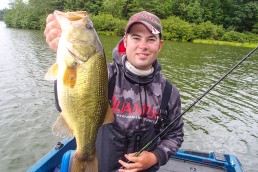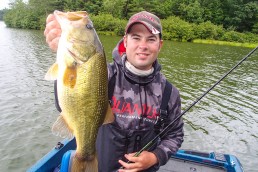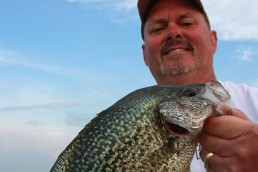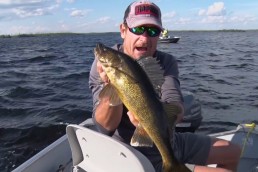Catching Largemouths in Foul Weather
SHARE THIS POST
Turn oppressive summer heat waves and cold fronts into a hot bass bite
A bad day of fishing is always better than the best day at work. In midsummer, the worst day of weather could be one of the best days you’ll experience, as long as you’re fishing for for largemouth bass. Even he most foul and pervasive summer conditions can help lead to your best and most aggressive bites of the year. I learned this lesson myself last July, when I found myself taking fishing a cold front at the end of the month.
The summer season delivers heat waves, and with it the oppressive heat bakes water temperatures, halting bass activity and perhaps our motivation to fish altogether. However, the best things to come from heat waves are storms, heavy rainfall, and their passing fronts on the back end. Midsummer cold fronts might not be as drastic as other seasons’ but rainy weather, overcast skies, and fronts can pass slowly and alter the underwater ecosystem. A foul day in midsummer provides much needed recovery and cooling for lakes with hot water temperatures, and recovery for bass as they regain activity and feed heavily.
When the going gets tough, the tough anglers will get going and return to the water. This break in the weather activates lake ecosystems again. On heavily vegetated lakes, foul weather sets up an explosive shallow-water largemouth bass bite.
Behemoth bucketmouths
July 2018 was warm and oppressive throughout the upper Midwest. Ninety and 100-degree days were the norm, resulting in mid 80-degree water temperatures, algae blooms, and slow fishing. It wasn’t until late July when a significant weather change finally came, disrupting the heat waves and altering our fishing.
That’s when a massive four-day cold front was incoming, about to positively change the entire landscape and underwater ecosystem of every bass fishery. The fishing up to this point was unsatisfactory to me, and the day before an important two-day guide trip allowed me to reconsider my summer strategy of usually fishing cold, deep lakes to counter with summertime heat. Largemouth bass are my most sought after fish species in cold front conditions, and I wanted to try something new. During this trip and the days after, shallow weed bowls, which I otherwise would never fish in midsummer, became my lakes of choice.
Foul weather and cold fronts often worsen the fishing on deep, clear water fisheries because their good visibility and sparse weed growth deprives fish of adequate cover and habitat to help bass and their swim bladders cope with the conditions. However, it improves the fishing and bass activity on fertile, nutrient rich lakes that are shallow, weedy, and often in summer algae bloom. Their reduced visibility and abundant habitat benefits all species inhabiting them.
Usually unfishable in midsummer due to hot water temperature, stagnation and low dissolved oxygen levels, these lakes cool quickly and recover in summer cold fronts. Their largemouth bass react positively to the lake’s own reaction. On eutrophic and late mesotrophic waters, largemouth bass use algae bloom to prowl low-visibility shallows in stealth. They will also set up in and around the shallow weeds and slop for ambushing the lake’s bluegills, perch, frogs, and other forage species.
Largemouth bass are masters at adaptation, utilizing a lake’s available habitat and biological changes to their benefit; so bass anglers must adapt as they do, and fish these waters in midsummer when they rapidly recover from heat and become fishable again.
On day one of our two-day summer cold front trip, my guide customer Sam and I experienced one of the best trophy largemouth bass bites in my boat’s history. Air temps in the low 60s, a big northwest wind, and periodic rain throughout the day fired up the entire ecosystem, stagnant and lifeless just a day earlier, in ways I can’t recall having witnessed before.
As a response to the cooldown, the largemouths slid back to the shallows to feed. Fishing various pockets and sections of shoreline, prowling through the inside and outside weed lines of coontail and surface slop with swim jigs and beefy trailers, we were able to catch largemouths of epic proportions.
Our full day’s catch was upwards of 40 largemouths; a solid day’s work. But our top dozen fish, all caught during a three-hour midday feeding spree, was an astonishing 50-pound sack of 18- to 21-inch trophy specimens. The full day encompassed multiple personal bests for Sam, and the fastest action of huge midsummer largemouths I have ever experienced. The weather change, along with our willingness to adapt with the fish, made this all possible.
Shallow weed bowls
These largemouth lakes are usually featureless, lacking topography, structure, depth and basins. But in midsummer many are rich in near-shore emergent and submergent vegetation, and weed beds galore. Most lakes have a depth consistency of 5 to 10 feet and can max out at 15 to 20 feet, assuring wintering survival. On these featureless weed bowls, largemouth bass and many of the lake’s other species tend to gravitate to their near-shore areas where habitat is best and most diverse. Anglers must do the same too.
Some shoreline areas can be wood oriented, while others are weed oriented. Probing through the shallows and casting or flipping to all targets in-between weed cover is the name of this game. Coontail and cabbage beds, slop, downed trees, pads, reeds and cattails are just a handful of high-percentage targets to look for and focus on.
Shallow-oriented fishing is simplistic, visual, and mostly based on your prior knowledge of the lake and where its best habitats are located. Electronics are only useful to gauge water temperature, and side imaging to help identify good weed species and finding the best weed lines and pockets.
The swim jig and casting jig are two of the most effective lures to employ in this situation. One presentation is built for speed and covering water, and the other for slower fishing and precise lure placements.
Whether fishing intentions are to power fish with a search lure or to extract bass from high-percentage locations and the worst cover, the swim jigs and K-Plunk casting jigs by Super-K Jigs are universally effective on all shallow largemouth weed bowls.
Are you enjoying this post?
You can be among the first to get the latest info on where to go, what to use and how to use it!
Shade, ambush points, bluegills, and young-of-the-year yellow perch are the main draws to largemouths in these locations. Largemouth bass and bluegill prey connections are most obvious during this time of season. On most algae bloom waters, a dark black/blue or black/chartreuse 3/8-ounce or 1/2-ounce swim jig paired with a high powering and vibrating 4-inch paddletail swimmer or creature will effectively represent a fleeing bluegill that not many other presentations could. For best contrast to poor water clarity, dark jig and trailer colors are preferred at all times.
Trailers are the business end of all jigs, and play a more important role than the weedless properties of the jig itself, in that the trailer, not the jig, is what will ultimately trigger a strike. It’s always important to mix and match between the different variables of tail action, vibration, size, color combination, and to keep note of how different combinations of these variables trigger fish. There are so many potential trailer styles to consider, but I always fish with baits that have previously worked for me as standalone lures (a rig of its own, by itself). From there, odds are excellent that it will work great, and potentially better, when paired with a jig.
On swim jigs, a larger, bulkier trailer often yields the biggest largemouths. I like to overpower them in summer with a full 4-inch paddletail that produces a wide tail kick and side-to-side wobble. Vibration of trailer is the most critical triggering point in reduced visibility (think: midsummer algae bloom) waters. In many murky water clarities and weedy jungles, baits that move too fast may avoid a bass’s strike zone before it could catch a glimpse of the lure. In these situations, I like to slow my retrieve and tip the jigs with creatures. Creature baits encompass crayfish variations, and often don’t resemble anything living in the wild. What makes them work are their appendages and tails, and bulkiness that helps add size and greater profile to the swim jig. For best color contrast and total jig package, pair the jig with a dark trailer color.
Other presentations besides jig and trailer combos will work. Weighted and weedless 4- to 5-inch paddletails with wide tail kick and wobble are good for active fish, and so too is a black and blue Chatterbait Freedom—by Freedom Tackle Corp—fished in combo with the same trailer styles.
In high-percentage areas holding multiple bass, I find it behooves me to have some slow presentations and reinforcements accessible. Often, a Texas-rigged creature bait, or slither rig flipped into pockets and openings with braided line extracts fish. Too, the simplest and most effective most effective bait you’ll will be Kalin’s Wacko Worms—flip them into pockets and openings, and glide them along weedlines to trigger strikes all day.
If light rain conditions become calm and humid, a surface frog such as Vexan Fishing’s Ninja Frog, popped and swum through slop, will get slurped right up by a midsummer largemouth.
The fishing is simple, but calls for multi-purpose setups. Have two medium-heavy to heavy action rods rigged and ready, and interchange when needed.
I tend to fish swim jigs and paddletails with a MH fast action 7- to 7-foot, 2-inch Vexan Bass and Quantum PT baitcasting rod accompanied by Quantum Icon PT reels with a 7.0:1 gear ratio. This faster gear ratio helps bring in slack line, in addition maintain a quicker retrieve speed without blowing baits by fish. Since we’re extracting bass through cover and poor water clarity, I try to fish swim jigs with braided line as much as possible. Cortland Masterbraid in 20- and 30-pound size is my preference. Sometimes I also fish the setup with heavy copolymer line such as Cortland’s Camo (15 pounds), which is strong enough and minimal in stretch to handle the occasional wrap-around from 4-pounders in heavy weeds.
For everything else from froggin’ to pitching jigs, I work with a 7-foot, 2-inch heavy, fast-action custom-built Batson casting rod, paired with a Quantum Tour S3 casting reel spooled with 20-pound Cortland Masterbraid. In the worst slop conditions I will bust out the heavier fiberglass Lamiglas flipping stick, spooled with 50-pound Masterbraid.
Even though summer delivers oppressive heat waves that halt fishing success, there’s always relief and recovery on its way from the incoming fronts that follow. If you ever thought shallow, warm water, weed infested lakes were unfishable this time of season, reconsider when a cold front strikes. Water temperatures will cool and recover, re-activating lake ecosystems again and awakening fish species from summer dormancy. This not only applies for largemouth bass and other warm water species, but for walleyes, northern pike and muskies too. When the habitat is just right and plentiful, foul weather sets up the best largemouth bite you might ever experience—not just in the summer, but in your life. MWO
Andrew Ragas splits time between Chicago and Wisconsin’s Northwoods. Based in Minocqua, Wis., he specializes in trophy bass fishing and offers guided trips from May through October. While big bass are his passion, he dabbles in multispecies, as well. He may be visited online at northwoodsbass.com.
A 6-pound largemouth is considered a giant for northern bass. Guide customer Sam Duell holds one of the biggest and heaviest bucketmouths caught in recent Vilas County, Wis. fishing history.
The darker and crummier the midsummer day, the better this shallow weed bite develops and materializes.
On swim jigs, the biggest largemouths are often triggered by a larger, bulkier trailer. Overpower them in summer with a full 4-inch paddletail that produces a wide tail kick and side-to-side wobble. Vibration of trailer is the most critical triggering point in reduced visibility/ algae bloom waters.
Shallow jungle fishing is simple when covering all of the bases. A casting jig and swim jig with an assortment of jig trailers gets fished most often. Then if conditions and depths allow, use crankbaits to probe through deeper weed lines and surface baits that can plow through slop.
MWO
SHARE THIS POST
Did you enjoy this post?
You can be among the first to get the latest info on where to go, what to use and how to use it!
Andrew Ragas
Andrew Ragas splits time between Chicago and Wisconsin’s Northwoods. Based in Minocqua, Wis., he specializes in trophy bass fishing and offers guided trips from May through October. While big bass are his passion, he dabbles in multispecies, as well. He may be visited online at northwoodsbass.com



